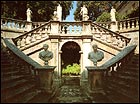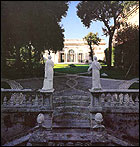|
 the Collection the Collection · the Statues 
 t the bottom of the big entrance courtyard, to the left of the portico, there is the entrance to a small courtyard surrounded by high walls. At the end there is a gate into the via della Consulta; on the right, through a grille, you can catch a glimpse of the Water Theatre with the fountain of the rivers. t the bottom of the big entrance courtyard, to the left of the portico, there is the entrance to a small courtyard surrounded by high walls. At the end there is a gate into the via della Consulta; on the right, through a grille, you can catch a glimpse of the Water Theatre with the fountain of the rivers.

|
The double entrance staircase
designed and built
by Vasanzio.
|
From the small courtyard on the left you can enter the hanging garden and the Casino dell'Aurora. A few travertine steps and before you, framed by the entrance portico and a ceiling decorated with little stalactites, appears the image of an outdoor double staircase: the "Scala della Pastorella". At the foot of the double stairs there is a small grotto with a ceiling covered with stalactites, a round arch frames its opening.
To the left and right, resting on the ends of the balusters, two marble busts of unknown personages have been waiting from time immemorial for the arrival of ancient guests.
The design of a coat of arms can be made out on the mosaic floor.
Halfway up the steps of the double staircase the flight is interrupted by a landing paved in mosaic with white, black and porphyry-red ornamental designs.

|
The staircase with the busts
and the statues seen from the
level of the garden
|
Along the stairs you notice other silent presences, marble busts looking down from the semicircular retaining wall that contains the whole structure. Other sculptures, full-figure female statues, face towards the garden. Some are certainly from the Roman period, others came from baroque stone dressers, and still others have probably been restored in more recent times.
The Casino's central hall is decorated with 17th century marble busts depicting Roman emperors and with sculptures from the Roman period, including the famous "Artemis the Huntress " and the "Rospigliosi Athena".

|
Artemis
the Huntress
|
Artemis the Huntress is a Hellenistic statue, the most complete one known since it still has its head and, at the base, the dog with the protome of a wild boar. The sculpture conforms to Hellenistic taste in the pose and the drapery and does not even stray from it in the dressing of the hair. The tunic worn by the goddess is a flimsy chiton shortened by a girdle, which it bloused fully over it and is then belted immediately under the bosom by another girdle, knotted over the chest.

|
Athena
Rospigliosi
|
The "Rospigliosi Athena", created by Timotheos in the 4th century, represents Athena Aithia, a marine and sidereal deity, made by the artist for the city of Megara.
|
|
|
